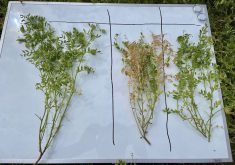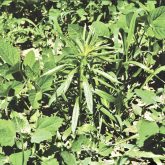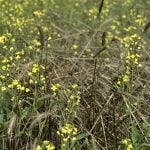Whether you’re an old hand at growing lentils, or relatively inexperienced, it’s worth brushing up on a few harvest tips before the combines start rolling.
Harvest success begins before seeding. It’s best to pick land that’s fairly level and stone-free, says Dale Risula, provincial specialist with Saskatchewan Agriculture in Regina.
“Rolling your land is a really crucial point, particularly if you are going to be sowing the small reds, which are shorter-statured plants,” Risula adds.
Harvest procedures are similar for both the larger green and small red lentils. But the greens are a little more indeterminate in their growth.
Read Also

Producers aren’t panicking over tariffs and trade threats
The influence of tariff and trade uncertainity on farm business decisions.
“Basically that means they’ll keep flowering or keep growing until they get a stress of some kind — heat, drought, low nitrogen,” says Shannon Chant, regional crops specialist with Saskatchewan Agriculture in Swift Current.
That means farmers will need to apply a desiccant or a pre-harvest herbicide to green lentils such as glyphosate to dry down the crop, making it more uniform for harvest. Most farmers desiccate red lentils too, says John Ippolito, Saskatchewan Agriculture regional crop specialist in Kindersley.
Farmers have choices when it comes to desiccants and pre-harvest herbicides. Ippolito suggests farmers think about what they’re trying to achieve when picking a chemical.
For example, glyphosate is really a pre-harvest weed control, mainly for perennials. As a result “it’s a really slow dry-down product,” says Ippolito. But, he says, many farmers in his area prefer it because it controls weeds.
Glyphosate can also decrease germination, so farmers wanting to save seed should look at a different product. Ippolito says some farmers avoid using glyphosate on a portion of their lentils so they can save seed.
Whether farmers are using glyphosate, a diquat such as Reglone, or a different product, timing is crucial.
“A lot of people seem to have the idea they can apply a desiccant and speed up maturity,” says Risula. But the chemicals actually help dry down a crop that’s already mature, he says. In fact, applying desiccants or glyphosate too early is more likely to leave residue in the grain, causing problems with maximum residue limits (MRLs), Risula adds.
But waiting too long has its risks, too.
“If it does get hot and dry, they can get away on you quite quickly,” says Ippolito. Last year he walked into a field slated for desiccation that day. “And there was already seed on the ground.”
Chant cautions farmers should check labels for desiccation timing, as it does vary between products. Most products are applied at around 30 per cent moisture. Lower pods will be tan or brown, and rattle in the pod. Middle pods will also be brown. The top might have green pods, or even still be flowering.
Most of the yield comes from the lower pods, so farmers are better off trying to keep them from shattering than worrying about whether the top pods are ready to harvest. Risula says farmers are more likely to lose lentils from the top after desiccation anyway.
“They’re more subject to frost at that time of year,” says Risula. “And if you leave them too long, you’ll have smaller lentils in your sample.”
How long farmers will have to wait until harvest varies between products as well. Farmers using glyphosate are looking at two to three weeks before harvest, Ippolito says.
Crops sprayed with Diquat, on the other hand, will probably be ready to harvest after a week, assuming the weather cooperates, Ippolito adds.
Combining tips
Most farmers straight-cut lentils these days, and it’s usually preferable. If a crop has matured too quickly because of hot, dry weather, Risula says it might be better to swath. But farmers then run the risk of rain in the swath.
Large greens do retain their colour better when swathing, Ippolito says. But farmers are looking at least 10 days between swathing and combining, upping the weather risk. Desiccation and straight cutting don’t adversely affect red lentil quality, he adds.
Ippolito says lentils are “probably a little more prone to shattering than most of the other crops we deal with.”
All three crop specialists recommend combining a little on the tough side. Risula suggests combining at somewhere above 15 and below 20 per cent moisture. “If it’s outside of that range, you’re either going to get a mashing of the lentil or a cracking of the seed coat,” he says
Lentils have a fairly brittle seed coat when they dry, so they should be handled gently, Chant says. She suggests farmers should “slow everything down a bit” in their combines. Chant also suggests reducing speed while combining. “That will reduce your shattering and cutter bar issues.”
Higher humidity is easier on the lentils at harvest, Chant says. “If it’s really dry and really, really hot, too, then things are more brittle,” she adds.
She also suggests combining a bit of a field edge before harvesting the entire lentil crop.
“See if it’s chipping or if you need to change things, especially if you’re a first time lentil grower,” Chant says.
Once in the bin, green lentils should be dried down to 14 per cent, and reds 13 per cent, Chant says.
If lentils have been harvested under a lot of heat, they’ll be gassing off moisture and CO2 in the bin, Risula says. It’s wise to aerate and monitor lentils closely in these circumstances, he adds. Any green material will also make it harder to dry the grain, he adds.
Ideally, farmers will have controlled any disease earlier in the growing season.
“If you know that there’s disease in it, then chances are it’s not going to make very good quality seed the following year because some of those diseases can be carried over from one year to another on the seed coat,” says Risula.
Farmers growing both red and green lentils need to thoroughly clean trucks and equipment between the two lentil types, Chant says.
“I kind of think Christmas lentils look a little festive but the buyers don’t want them,” she jokes.
”So avoid Christmas lentils.”
Farmers can reach crop specialists, including John Ippolito, Shannon Chant, and Dale Risula, by calling the Ag Knowledge Centre at 1-866-457-2377. Staff members are available to answer general questions or to do field calls, Chant says.
Both the Saskatchewan Pulse Growers and Saskatchewan Agriculture have information on growing lentils at the Saskatchewan Pulse Growers and Saskatchewan Agriculture websites.
This article first appeared in the June 7, 2016 issue of Grainews
















